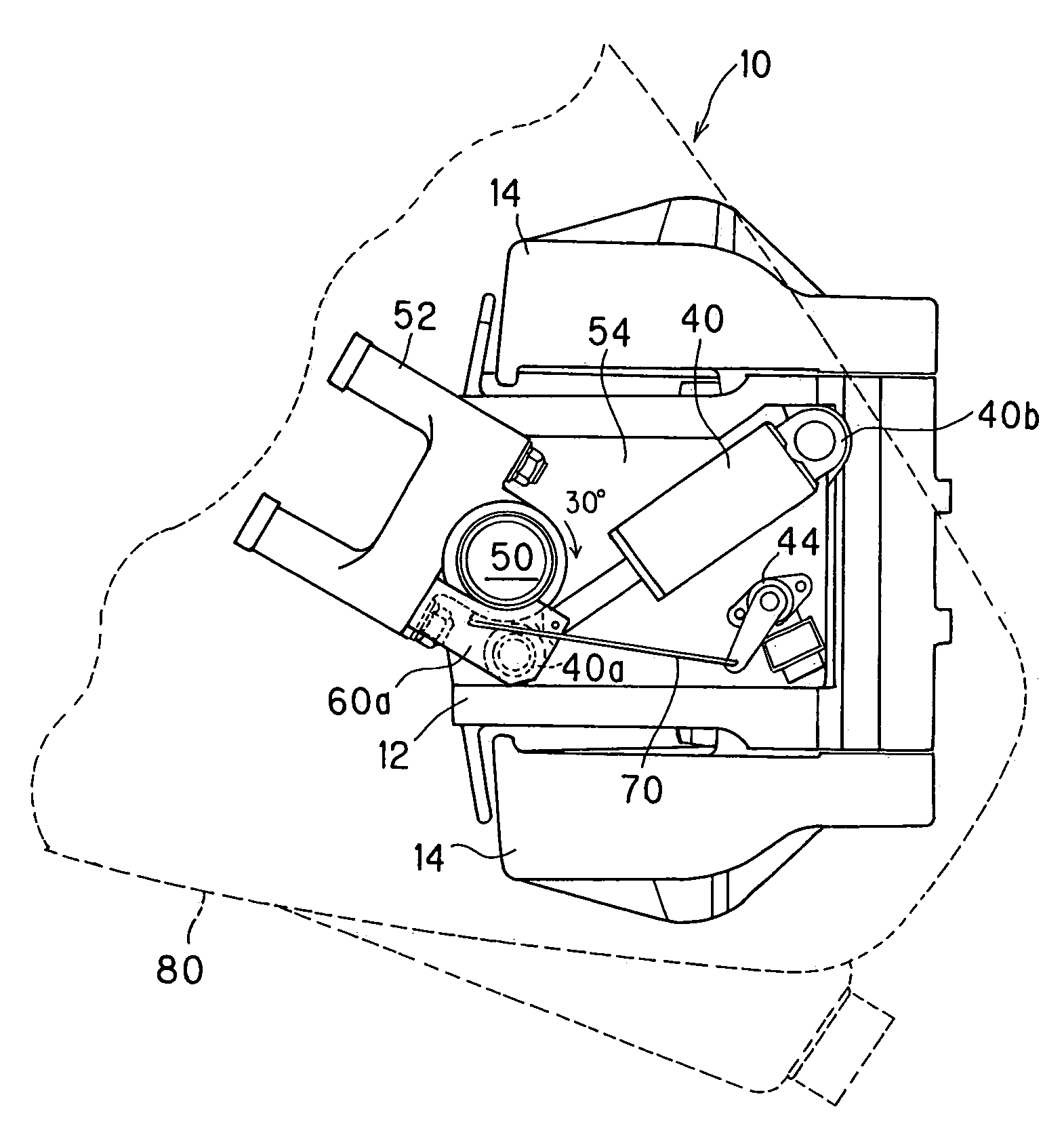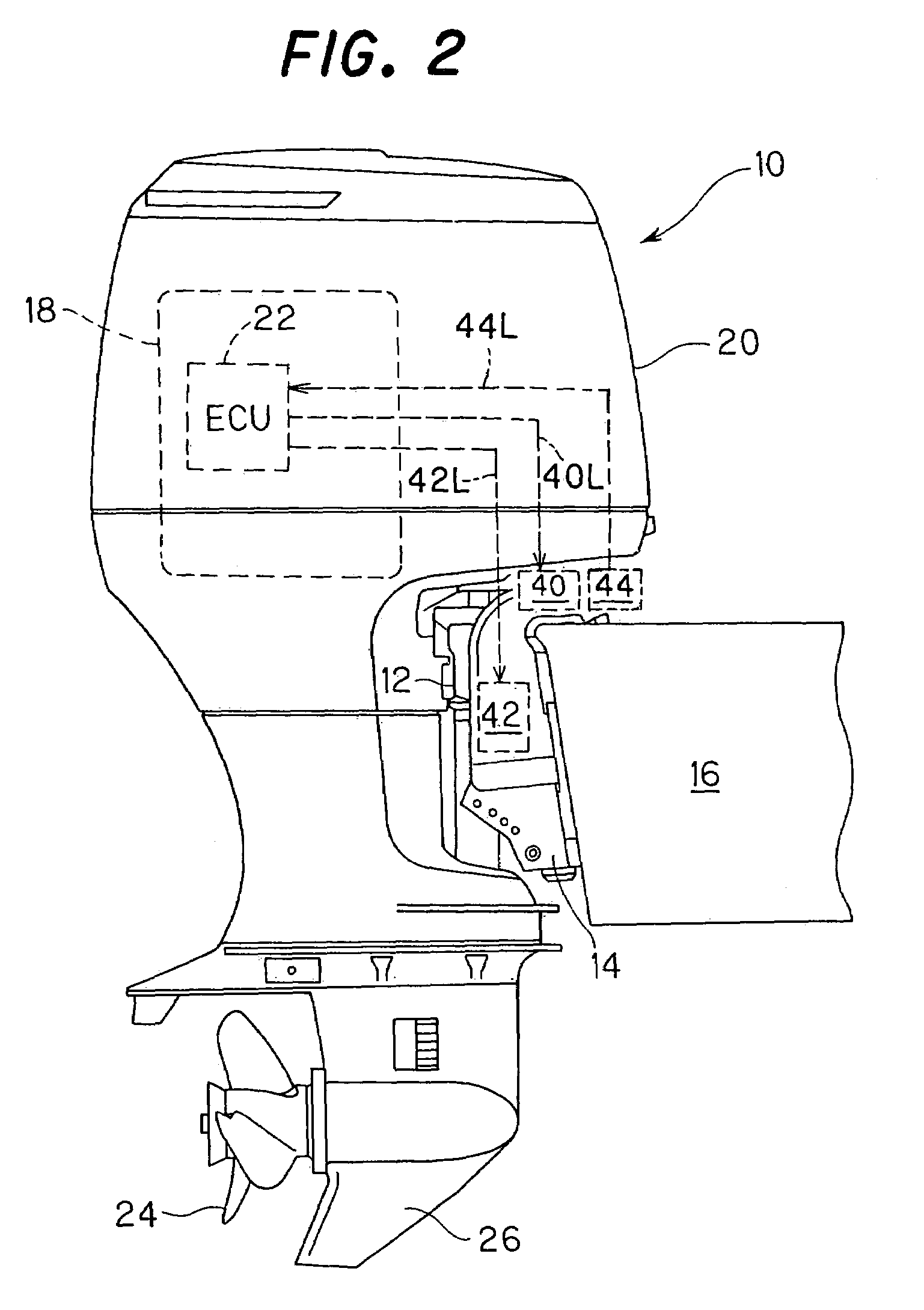Outboard motor steering system
a steering system and motor technology, applied in the direction of propulsive elements, marine propulsion, vessel construction, etc., can solve the problems of increasing the number and weight of components, the structure is complicated, and the disadvantages of human-powered steering systems, so as to improve the steering feel
- Summary
- Abstract
- Description
- Claims
- Application Information
AI Technical Summary
Benefits of technology
Problems solved by technology
Method used
Image
Examples
first embodiment
[0041]FIG. 1 is an overall schematic view of the outboard motor steering system according to the invention, and FIG. 2 is an enlarged side view of an outboard motor illustrated in FIG. 1.
[0042]Reference numeral 10 in FIGS. 1 and 2 designates an outboard motor built integrally of an internal combustion engine, propeller shaft, propeller and other components. As illustrated in FIG. 2, the outboard motor 10 is mounted on the stern of a boat (hull) 16 via a swivel case 12 (that rotatably accommodates or houses a swivel shaft (not shown)) and stern brackets 14 (to which the swivel case 12 is connected), to be rotatable about the vertical and horizontal axes.
[0043]As shown in FIG. 2, the outboard motor 10 is equipped with an internal combustion engine 18 at its upper portion. The engine 18 is a spark-ignition, in-line four-cylinder gasoline engine with a displacement of 2,200 cc. The engine 18, located inside the outboard motor 10, is enclosed by an engine cover 20 and positioned above th...
second embodiment
[0077]As stated above, in the outboard motor steering system since the hydraulic cylinder 100 and the rotation angle sensor 102 are installed in the outboard motor, it becomes possible to prevent space utilization around the outboard motor and boat from being restricted.
[0078]Further, since the rotation angle sensor 102 is installed around the outer periphery (surface) of the swivel shaft 50, the detection accuracy is enhanced. Since the rotation angle sensor has a ring-like shape and is installed around the swivel shaft 50 in such a manner that the center 102c of the sensor 102 is equal to the center of rotation 50c of the swivel shaft 50, the detection accuracy is further enhanced. With this, since the outboard motor 10 is steered as desired by the operator, steering feel is further improved.
[0079]Further, since the rotation angle sensor 102 has the ring-like magnets 102a that are fixed to the outer surface of the swivel shaft 50 and the annular detection coils 102b that are fixe...
third embodiment
[0108]As stated above, in the outboard motor steering system since the first and second moving orifices 240 and 242 are provided in the hydraulic pressure circuit (as the hydraulic pressure relievers) which supplies hydraulic (oil) pressure to the hydraulic cylinder 200 (that rotates the swivel shaft 50 for steering) such that oil is returned to the oil tank 224 to relieve or reduce hydraulic pressure when hydraulic pressure rises sharply. With this, even when the outboard motor 10 is steered right or left sharply, since hydraulic pressure does not rise sharply, the operator can steer or turn the boat 16 smoothly and hence, the steering feel is improved.
[0109]Further, since the hydraulic pressure relievers comprise the first and second moving orifices 240 and 242 that can be simply installed in the hydraulic pressure circuit, the structure is simplified.
[0110]Further, the extent of pressure decrease or relief can be easily regulated by changing the cross-sectional area of the holes...
PUM
 Login to View More
Login to View More Abstract
Description
Claims
Application Information
 Login to View More
Login to View More - R&D
- Intellectual Property
- Life Sciences
- Materials
- Tech Scout
- Unparalleled Data Quality
- Higher Quality Content
- 60% Fewer Hallucinations
Browse by: Latest US Patents, China's latest patents, Technical Efficacy Thesaurus, Application Domain, Technology Topic, Popular Technical Reports.
© 2025 PatSnap. All rights reserved.Legal|Privacy policy|Modern Slavery Act Transparency Statement|Sitemap|About US| Contact US: help@patsnap.com



